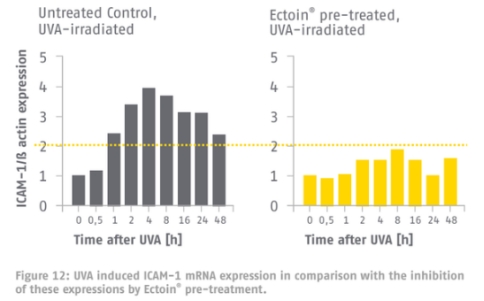The history of ectoine can be traced back to 1985; Professor Galinski found in the Egyptian desert that desert halophiles still grow well under the harsh environmental conditions of high temperature, dryness, strong UV irradiation and high salinity. In the outer layer of the cell, there is a natural protective component – ectoine with the excellent self-repair ability. Scientists continued to deepen the research, and found that ectoine not only has a strong anti-stress, but also proved to be effective in repairing the skin barrier ingredients. Ectoine has been found in saline soil, salt lake and sea water one after another. Nowadays, ectoine uses are mainly in many skincare products, due to it’s effective uses in moisturizing, UVA protection, repairing skin and others.
- Ectoine Uses in Moisturizing
Ectoine is an important substance to maintain the balance of osmotic pressure, and its unique molecular structure makes it a strong ability to complex water molecules. One molecule of ectoine can complex four or five water molecules, which can make the free water in the cell structured to reduce the evaporation of water in the skin, so that the skin’s ability to hold water continues to improve. Therefore, ectoine is an excellent moisturizer.
Ectoine reduces TEWL (Transdermal Water Loss), improves hydration and retains skin moisture for up to 7 days without reapplication.

Moreover, the cyclic structure of ectoine molecule has strong electronegativity, which is easy to form hydrogen bond with water molecules. Therefore, ectoine can enhance the bonding ability of water molecules, make water molecules oriented around it, and change the spatial arrangement of water molecules, i.e., ” Kosmotropic effect.”

More product details please click Ectoin Introduction.
- Ectoine Uses in UV Protection
UVA radiation, the main component of the ultraviolet solar spectrum that reaches the Earth, is 20 times more intense than UVB radiation and is thought to play a key role in photoaging, even including in the pathogenesis of photocarcinogenesis.
UVA exposure causes a series of linked reactions in the skin, inducing the activation of the transcription factor AP-2 and the expression of pro-inflammatory genes such as Intercellular Adhesion Molecule-1 (ICAM-1); matrix metalloproteins are also activated and lead to wrinkles through the degradation of extracellular matrix proteins; and induces mutations in mitochondrial DNA, leading to skin damage, among others.

There was a article “ectoine: an effective natural substance to prevent UVA-induced premature photoaging”, it said that three experiments from three directions confirmed that ectoine inhibits UVA-induced cascade effects and can almost completely counteract UVA radiation-induced ICAM-1 production.

In other words, the UV protection provided by ectoine inhibits the cellular senescence process in keratinocytes and fibroblasts.
- Ectoine Uses in Repairing Skin
Ectoine can stimulate the production of glycoaminoglycans (GAGs), to promote the production and construction of extracellular matrix known as proteoglycans. It continues to improve the skin’s epidermal cells as well as the natural moisture barrier of the water-holding capacity.
UV irradiation can damage Langerhans cells and reduced their activity. The UV damage to Langerhans cells was significantly reduced after treatment with ectoine. Compared with the positive control group, 1% ectoine increased the cells activity by 10.5% after 6 hours.

Figure. Ectoine enhances skin immune function
Heat Shock Proteins (HSP) are protective proteins synthesized by cells when they are attacked by high temperatures and other harsh environments. They can help the cells maintain normal physiological activities. When the cells are stimulated by heat, the expression of HSP rises rapidly for a short period of time and then gradually returns to the normal level. The higher the final expression of HSP, the more obvious the irritation.

Figure. The heat tolerance of cells was improved after ectoine treatment
The results showed that the heat tolerance of cells was improved after ectoine treatment. Compared with the positive control group, the expression level of HSP72 was significantly decreased.
There was another test result indicating that at the concentration of 0.5%-2.0%, ectoine had a good inhibitory effect on the pro-inflammatory factor TNF-α, so it can reduce the damage caused by inflammatory response to the skin.

Figure. Ectoine’S Inhibition of TNF-α
- Ectoine Uses in Anti-pollution
In 2016, scientists at Bitop conducted a study on the anti-pollution activity of ectoine. In the experiment, it was found that the use of a cream containing ectoine for five days reduced pollution-induced lipid peroxidation (MDA) overexpression by 34.2% compared to a placebo, and by 32.7% compared to an untreated control group. They concluded that ectoine provides immediate protection against a wide range of pollutants including turbid metals, polycyclic aromatic hydrocarbons, and airborne particle sizes (PM2.5, PM1, PM0.1, etc.).

Ectoine uses can be nicely with almost every imaginable skin-care formula, and it enhances the impact of ingredients that share its benefits. Ectoine combine well with other ingredients including moisturizing agent hyaluronic acid or glycerin, anti-aging ingredient bakuchiol, and barrier-strengthening ingredient like centella, ceramides. Meanwhile, it also helps to minimize the side effects of other irritating ingredients. For examples, it can work well when formulating with ingredients that cause inflammation or redness like AHA, BHA, and retinoids, to help conform their side effects.







